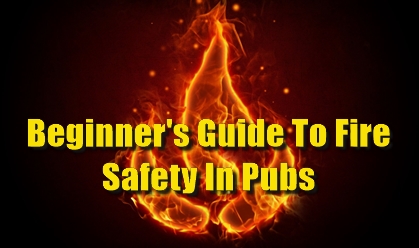Part of your responsibility for running a safe pub is to have fire extinguishers available in good working order to fight fire. There are several types of fire extinguisher used to fight different types of fire:
Class A: SOLIDS such as paper, wood, plastic etc
Class B: FLAMMABLE LIQUIDS such as paraffin, petrol, oil etc
Class C: FLAMMABLE GASES such as propane, butane, methane etc
Class D: METALS such as aluminium, magnesium, titanium etc
Class E: Fires involving ELECTRICAL APPARATUS
Class F: Cooking OIL & FAT etc
You are, in all likelihood, only going to fight a limited type of fire in your pub and are only going to require extinguishers to fight Class A, E and F fires. These are the types of fire extinguisher available:
Water Fire Extinguishers: They are the cheapest and most widely used fire extinguishers. Used for Class A fires they are not suitable for Class B (Liquid) fires, or where electricity is involved.
Foam Fire Extinguishers: these are more expensive than water, but more versatile. Used for Classes A & B fires, Foam spray extinguishers are not recommended for fires involving electricity, but are safer than water if inadvertently sprayed onto live electrical apparatus.
Dry Powder Fire Extinguishers: these can be used on classes A, B & C fires. Best for running liquid fires (Class B). Warning: when used indoors, powder can obscure vision or damage goods and machinery and they are also very messy.
CO2 Fire Extinguishers: Carbon Dioxide is ideal for fires involving electrical apparatus, and will also extinguish class B liquid fires, but has NO POST FIRE SECURITY and the fire could re-ignite.
Prior to 1st Jan 1997, the code of practice for fire extinguishers in the UK was BS 5423, which advised the colour coding of fire extinguishers as follows:
Water – Red
Foam – Cream
Dry Powder – Blue
Carbon Dioxide (CO2) – Black
Halon – Green (now ‘illegal’ in general use)
New extinguishers should conform to BS EN 3, which requires that the entire body of the extinguisher be coloured red. A coloured area of up to 5% of the external area can be used to identify the contents using the old colours. If you have any of the older coloured fire extinguishers you should replace them.
Fire extinguishers have a limited life, even if they remain unused. Contents can lose pressure, insides of the canisters rust and the canister seams can be weakened by continual high pressurization. Seals can deteriorate, valves can stick, and fire extinguishers get knocked and dented by virtue of being part of a pub’s fixtures and fittings.
Fire extinguisher maintenance and care in accordance with the Code of Practice stipulated in British Standard 5306 part 3 must be part of your pub’s Fire Risk Assessment and is, in effect, a legal requirement of the Regulatory Reform (Fire Safety) Order 2005.
You will need to organise annual inspections by a competent person. This involves inspecting every fire extinguisher and identifying those extinguishers which need servicing or have reached the end of their useful lives.
Refurbishing fire extinguishers is a long process so these days, most servicing companies just “service exchange” the unit for a ready-tested model. Be warned this can leave you with a different, sometimes inferior, model to the original, so check the terms and conditions of the contractor. Service exchange is usually significantly lower than the costs of a extinguisher replacement.
A visual check on your fire extinguishers once a month takes very little time, but can save both money and lives and is part of your legal duty.
Continue reading … page 2 • page 3
